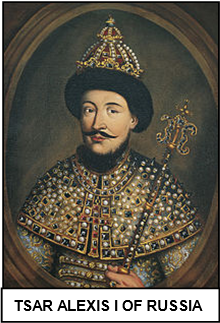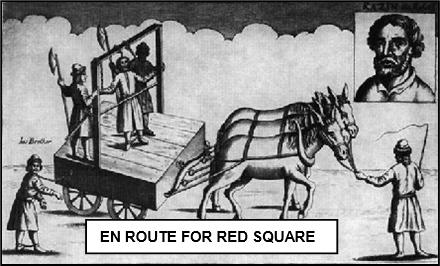


xxxxxAs we have seen, the young Michael Romanov became Tsar of Russia in 1613 (J1). Over the next ten years, peace was achieved by giving land to Sweden and Poland and keeping out of the Thirty Years’ War, and some progress was made in internal reform. His son Alexis, coming to power in 1645, regained some of the lost land, but his edict of 1649, giving the landed nobles even greater powers over their serfs, stored up future trouble. Many peasants fled to the Cossack settlements and, from here, joined in a powerful but unsuccessful revolt against the government in 1670, led by Stenka Razin. Fyodor III, who succeeded Alexis in 1676, took little part in government, and it was left to his half-
TSAR ALEXIS I OF RUSSIA 1645 -
Acknowledgements
Alexis: artist unknown, 1670s – Ptuj Ormoz Regional Museum, Slovenia. Razin: engraving, date and artist unknown.
 xxxxxAs we have seen, sixteen-
xxxxxAs we have seen, sixteen-
xxxxxWith the coming to power of his son, Alexis, in 1645, some success was achieved in regaining lost territory. In 1654 the Cossacks of the Ukraine, overthrowing their Polish masters, placed themselves under the protection of the Tsar. In the ensuing war with Poland -

xxxxxFurthermore, a law code adopted in 1649 giving the landed nobility much greater power over their serfs, and reducing the privileges of the Cossacks, stored up trouble for the future. Many serfs fled to the Cossack settlements situated along the lower stretches of the Volga, Dnieper and Don Rivers. Here they joined up with some 7,000 outlaw Cossacks, led by a charismatic leader named Stenka Razin, and in 1670 came out in rebellion. Fearing that the uprising might spread, the Tsar sent in his highly trained army and, despite the size of the uprising -
xxxxxFyodor III, who succeeded Alexis in 1676, took very little part in the affairs of government. He was a sickly child and died at the age of 20. He was well educated, however, and was much in favour of introducing Western culture into Russia. But, as we shall see (1689 W3), it was his half-
CW-


